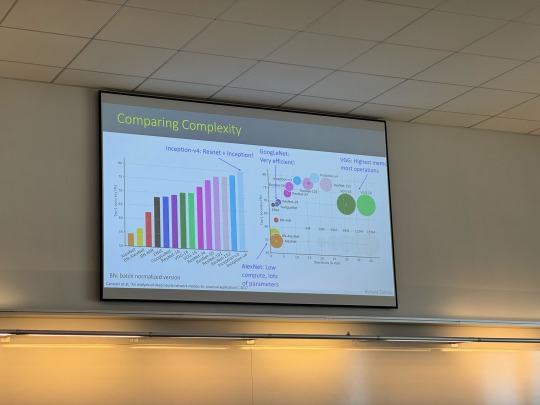#Deep Learning For Computer Vision
Explore tagged Tumblr posts
Text

NextGen Invent specializes in utilizing deep learning for computer vision applications. Our cutting-edge technology harnesses the power of artificial intelligence to revolutionize image processing and analysis. Join us in unlocking the potential of deep learning for computer vision projects.
0 notes
Text

Bayesian Active Exploration: A New Frontier in Artificial Intelligence
The field of artificial intelligence has seen tremendous growth and advancements in recent years, with various techniques and paradigms emerging to tackle complex problems in the field of machine learning, computer vision, and natural language processing. Two of these concepts that have attracted a lot of attention are active inference and Bayesian mechanics. Although both techniques have been researched separately, their synergy has the potential to revolutionize AI by creating more efficient, accurate, and effective systems.
Traditional machine learning algorithms rely on a passive approach, where the system receives data and updates its parameters without actively influencing the data collection process. However, this approach can have limitations, especially in complex and dynamic environments. Active interference, on the other hand, allows AI systems to take an active role in selecting the most informative data points or actions to collect more relevant information. In this way, active inference allows systems to adapt to changing environments, reducing the need for labeled data and improving the efficiency of learning and decision-making.
One of the first milestones in active inference was the development of the "query by committee" algorithm by Freund et al. in 1997. This algorithm used a committee of models to determine the most meaningful data points to capture, laying the foundation for future active learning techniques. Another important milestone was the introduction of "uncertainty sampling" by Lewis and Gale in 1994, which selected data points with the highest uncertainty or ambiguity to capture more information.
Bayesian mechanics, on the other hand, provides a probabilistic framework for reasoning and decision-making under uncertainty. By modeling complex systems using probability distributions, Bayesian mechanics enables AI systems to quantify uncertainty and ambiguity, thereby making more informed decisions when faced with incomplete or noisy data. Bayesian inference, the process of updating the prior distribution using new data, is a powerful tool for learning and decision-making.
One of the first milestones in Bayesian mechanics was the development of Bayes' theorem by Thomas Bayes in 1763. This theorem provided a mathematical framework for updating the probability of a hypothesis based on new evidence. Another important milestone was the introduction of Bayesian networks by Pearl in 1988, which provided a structured approach to modeling complex systems using probability distributions.
While active inference and Bayesian mechanics each have their strengths, combining them has the potential to create a new generation of AI systems that can actively collect informative data and update their probabilistic models to make more informed decisions. The combination of active inference and Bayesian mechanics has numerous applications in AI, including robotics, computer vision, and natural language processing. In robotics, for example, active inference can be used to actively explore the environment, collect more informative data, and improve navigation and decision-making. In computer vision, active inference can be used to actively select the most informative images or viewpoints, improving object recognition or scene understanding.
Timeline:
1763: Bayes' theorem
1988: Bayesian networks
1994: Uncertainty Sampling
1997: Query by Committee algorithm
2017: Deep Bayesian Active Learning
2019: Bayesian Active Exploration
2020: Active Bayesian Inference for Deep Learning
2020: Bayesian Active Learning for Computer Vision
The synergy of active inference and Bayesian mechanics is expected to play a crucial role in shaping the next generation of AI systems. Some possible future developments in this area include:
- Combining active inference and Bayesian mechanics with other AI techniques, such as reinforcement learning and transfer learning, to create more powerful and flexible AI systems.
- Applying the synergy of active inference and Bayesian mechanics to new areas, such as healthcare, finance, and education, to improve decision-making and outcomes.
- Developing new algorithms and techniques that integrate active inference and Bayesian mechanics, such as Bayesian active learning for deep learning and Bayesian active exploration for robotics.
Dr. Sanjeev Namjosh: The Hidden Math Behind All Living Systems - On Active Inference, the Free Energy Principle, and Bayesian Mechanics (Machine Learning Street Talk, October 2024)
youtube
Saturday, October 26, 2024
#artificial intelligence#active learning#bayesian mechanics#machine learning#deep learning#robotics#computer vision#natural language processing#uncertainty quantification#decision making#probabilistic modeling#bayesian inference#active interference#ai research#intelligent systems#interview#ai assisted writing#machine art#Youtube
6 notes
·
View notes
Text
Tom and Robotic Mouse | @futuretiative
Tom's job security takes a hit with the arrival of a new, robotic mouse catcher.
TomAndJerry #AIJobLoss #CartoonHumor #ClassicAnimation #RobotMouse #ArtificialIntelligence #CatAndMouse #TechTakesOver #FunnyCartoons #TomTheCat
Keywords: Tom and Jerry, cartoon, animation, cat, mouse, robot, artificial intelligence, job loss, humor, classic, Machine Learning Deep Learning Natural Language Processing (NLP) Generative AI AI Chatbots AI Ethics Computer Vision Robotics AI Applications Neural Networks
Tom was the first guy who lost his job because of AI
(and what you can do instead)
⤵
"AI took my job" isn't a story anymore.
It's reality.
But here's the plot twist:
While Tom was complaining,
others were adapting.
The math is simple:
➝ AI isn't slowing down
➝ Skills gap is widening
➝ Opportunities are multiplying
Here's the truth:
The future doesn't care about your comfort zone.
It rewards those who embrace change and innovate.
Stop viewing AI as your replacement.
Start seeing it as your rocket fuel.
Because in 2025:
➝ Learners will lead
➝ Adapters will advance
➝ Complainers will vanish
The choice?
It's always been yours.
It goes even further - now AI has been trained to create consistent.
//
Repost this ⇄
//
Follow me for daily posts on emerging tech and growth
#ai#artificialintelligence#innovation#tech#technology#aitools#machinelearning#automation#techreview#education#meme#Tom and Jerry#cartoon#animation#cat#mouse#robot#artificial intelligence#job loss#humor#classic#Machine Learning#Deep Learning#Natural Language Processing (NLP)#Generative AI#AI Chatbots#AI Ethics#Computer Vision#Robotics#AI Applications
4 notes
·
View notes
Text






Day 19/100 days of productivity | Fri 8 Mar, 2024
Visited University of Connecticut, very pretty campus
Attended a class on Computer Vision, learned about Google ResNet, which is a type of residual neural network for image processing
Learned more about the grad program and networked
Journaled about my experience
Y��all, UConn is so cool! I was blown away by the gigantic stadium they have in the middle of campus (forgot to take a picture) for their basketball games, because apparently they have the best female collegiate basketball team in the US?!? I did not know this, but they call themselves Huskies, and the branding everyone on campus is on point.
#100 days of productivity#grad school#computer vision#google resnet#neural network#deep learning#UConn#uconn huskies#uconn women’s basketball#university of Connecticut
11 notes
·
View notes
Text
7 Computer Vision Projects for All Levels - KDnuggets
2 notes
·
View notes
Text
#artificial intelligence services#machine learning solutions#AI development company#machine learning development#AI services India#AI consulting services#ML model development#custom AI solutions#deep learning services#natural language processing#computer vision solutions#AI integration services#AI for business#enterprise AI solutions#machine learning consulting#predictive analytics#AI software development#intelligent automation
0 notes
Text

Umiejętności AI Zwiększają Szanse na Zatrudnienie? Sprawdź! Czy umiejętności AI otwierają drzwi do lepszej pracy? Analizujemy popyt na specjalistów AI i kluczowe kompetencje, które musisz znać aby zwiększyć swoje szanse na zatrudnienie.
Czytaj więcej
#sztuczna inteligencja#umiejętności AI#rynek pracy#zatrudnienie AI#kariera IT#uczenie maszynowe#deep learning#przetwarzanie języka naturalnego#computer vision
0 notes
Text
Discover Rydot's ConvAI Platform, where generative AI transforms ideas into reality. Unleash the potential of intelligent assistance for your projects today.
0 notes
Text
Machine learning applications in semiconductor manufacturing
Machine Learning Applications in Semiconductor Manufacturing: Revolutionizing the Industry
The semiconductor industry is the backbone of modern technology, powering everything from smartphones and computers to autonomous vehicles and IoT devices. As the demand for faster, smaller, and more efficient chips grows, semiconductor manufacturers face increasing challenges in maintaining precision, reducing costs, and improving yields. Enter machine learning (ML)—a transformative technology that is revolutionizing semiconductor manufacturing. By leveraging ML, manufacturers can optimize processes, enhance quality control, and accelerate innovation. In this blog post, we’ll explore the key applications of machine learning in semiconductor manufacturing and how it is shaping the future of the industry.
Predictive Maintenance
Semiconductor manufacturing involves highly complex and expensive equipment, such as lithography machines and etchers. Unplanned downtime due to equipment failure can cost millions of dollars and disrupt production schedules. Machine learning enables predictive maintenance by analyzing sensor data from equipment to predict potential failures before they occur.
How It Works: ML algorithms process real-time data from sensors, such as temperature, vibration, and pressure, to identify patterns indicative of wear and tear. By predicting when a component is likely to fail, manufacturers can schedule maintenance proactively, minimizing downtime.
Impact: Predictive maintenance reduces equipment downtime, extends the lifespan of machinery, and lowers maintenance costs.
Defect Detection and Quality Control
Defects in semiconductor wafers can lead to significant yield losses. Traditional defect detection methods rely on manual inspection or rule-based systems, which are time-consuming and prone to errors. Machine learning, particularly computer vision, is transforming defect detection by automating and enhancing the process.
How It Works: ML models are trained on vast datasets of wafer images to identify defects such as scratches, particles, and pattern irregularities. Deep learning algorithms, such as convolutional neural networks (CNNs), excel at detecting even the smallest defects with high accuracy.
Impact: Automated defect detection improves yield rates, reduces waste, and ensures consistent product quality.
Process Optimization
Semiconductor manufacturing involves hundreds of intricate steps, each requiring precise control of parameters such as temperature, pressure, and chemical concentrations. Machine learning optimizes these processes by identifying the optimal settings for maximum efficiency and yield.
How It Works: ML algorithms analyze historical process data to identify correlations between input parameters and output quality. Techniques like reinforcement learning can dynamically adjust process parameters in real-time to achieve the desired outcomes.
Impact: Process optimization reduces material waste, improves yield, and enhances overall production efficiency.
Yield Prediction and Improvement
Yield—the percentage of functional chips produced from a wafer—is a critical metric in semiconductor manufacturing. Low yields can result from various factors, including process variations, equipment malfunctions, and environmental conditions. Machine learning helps predict and improve yields by analyzing complex datasets.
How It Works: ML models analyze data from multiple sources, including process parameters, equipment performance, and environmental conditions, to predict yield outcomes. By identifying the root causes of yield loss, manufacturers can implement targeted improvements.
Impact: Yield prediction enables proactive interventions, leading to higher productivity and profitability.
Supply Chain Optimization
The semiconductor supply chain is highly complex, involving multiple suppliers, manufacturers, and distributors. Delays or disruptions in the supply chain can have a cascading effect on production schedules. Machine learning optimizes supply chain operations by forecasting demand, managing inventory, and identifying potential bottlenecks.
How It Works: ML algorithms analyze historical sales data, market trends, and external factors (e.g., geopolitical events) to predict demand and optimize inventory levels. Predictive analytics also helps identify risks and mitigate disruptions.
Impact: Supply chain optimization reduces costs, minimizes delays, and ensures timely delivery of materials.
Advanced Process Control (APC)
Advanced Process Control (APC) is critical for maintaining consistency and precision in semiconductor manufacturing. Machine learning enhances APC by enabling real-time monitoring and control of manufacturing processes.
How It Works: ML models analyze real-time data from sensors and equipment to detect deviations from desired process parameters. They can automatically adjust settings to maintain optimal conditions, ensuring consistent product quality.
Impact: APC improves process stability, reduces variability, and enhances overall product quality.
Design Optimization
The design of semiconductor devices is becoming increasingly complex as manufacturers strive to pack more functionality into smaller chips. Machine learning accelerates the design process by optimizing chip layouts and predicting performance outcomes.
How It Works: ML algorithms analyze design data to identify patterns and optimize layouts for performance, power efficiency, and manufacturability. Generative design techniques can even create novel chip architectures that meet specific requirements.
Impact: Design optimization reduces time-to-market, lowers development costs, and enables the creation of more advanced chips.
Fault Diagnosis and Root Cause Analysis
When defects or failures occur, identifying the root cause can be challenging due to the complexity of semiconductor manufacturing processes. Machine learning simplifies fault diagnosis by analyzing vast amounts of data to pinpoint the source of problems.
How It Works: ML models analyze data from multiple stages of the manufacturing process to identify correlations between process parameters and defects. Techniques like decision trees and clustering help isolate the root cause of issues.
Impact: Faster fault diagnosis reduces downtime, improves yield, and enhances process reliability.
Energy Efficiency and Sustainability
Semiconductor manufacturing is energy-intensive, with significant environmental impacts. Machine learning helps reduce energy consumption and improve sustainability by optimizing resource usage.
How It Works: ML algorithms analyze energy consumption data to identify inefficiencies and recommend energy-saving measures. For example, they can optimize the operation of HVAC systems and reduce idle time for equipment.
Impact: Energy optimization lowers operational costs and reduces the environmental footprint of semiconductor manufacturing.
Accelerating Research and Development
The semiconductor industry is driven by continuous innovation, with new materials, processes, and technologies being developed regularly. Machine learning accelerates R&D by analyzing experimental data and predicting outcomes.
How It Works: ML models analyze data from experiments to identify promising materials, processes, or designs. They can also simulate the performance of new technologies, reducing the need for physical prototypes.
Impact: Faster R&D cycles enable manufacturers to bring cutting-edge technologies to market more quickly.
Challenges and Future Directions
While machine learning offers immense potential for semiconductor manufacturing, there are challenges to overcome. These include the need for high-quality data, the complexity of integrating ML into existing workflows, and the shortage of skilled professionals. However, as ML technologies continue to evolve, these challenges are being addressed through advancements in data collection, model interpretability, and workforce training.
Looking ahead, the integration of machine learning with other emerging technologies, such as the Internet of Things (IoT) and digital twins, will further enhance its impact on semiconductor manufacturing. By embracing ML, manufacturers can stay competitive in an increasingly demanding and fast-paced industry.
Conclusion
Machine learning is transforming semiconductor manufacturing by enabling predictive maintenance, defect detection, process optimization, and more. As the industry continues to evolve, ML will play an increasingly critical role in driving innovation, improving efficiency, and ensuring sustainability. By harnessing the power of machine learning, semiconductor manufacturers can overcome challenges, reduce costs, and deliver cutting-edge technologies that power the future.
This blog post provides a comprehensive overview of machine learning applications in semiconductor manufacturing. Let me know if you’d like to expand on any specific section or add more details!
#semiconductor manufacturing#Machine learning in semiconductor manufacturing#AI in semiconductor industry#Predictive maintenance in chip manufacturing#Defect detection in semiconductor wafers#Semiconductor process optimization#Yield prediction in semiconductor manufacturing#Advanced Process Control (APC) in semiconductors#Semiconductor supply chain optimization#Fault diagnosis in chip manufacturing#Energy efficiency in semiconductor production#Deep learning for semiconductor defects#Computer vision in wafer inspection#Reinforcement learning in semiconductor processes#Semiconductor yield improvement using AI#Smart manufacturing in semiconductors#AI-driven semiconductor design#Root cause analysis in chip manufacturing#Sustainable semiconductor manufacturing#IoT in semiconductor production#Digital twins in semiconductor manufacturing
0 notes
Text
Yay! Deep learning gonna save the douglas-fir (research project attempting to quantize needle loss in order to breed for resistance to Swiss Needle Cast Disease)

#douglas fir#deep learning#ai#Swiss needle cast#research#research project#climate change#computer vision#environment#west coast
0 notes
Text

Explore the innovative capabilities of NextGen Invent, a cutting-edge platform utilizing deep learning for computer vision applications. Stay ahead of the curve with NextGen's sophisticated technology that revolutionizes visual recognition and analysis, unlocking new possibilities in image processing and object detection. Elevate your projects with NextGen Invent's powerful deep learning algorithms tailored for computer vision tasks.
0 notes
Text
Ứng dụng mạng ResNet-50 vào phân loại hình ảnh
📸 Ứng dụng mạng ResNet-50 vào phân loại hình ảnh - Tương lai của công nghệ AI! 🌟
Trong thời đại 4.0, trí tuệ nhân tạo (AI) đã và đang phát triển với tốc độ chóng mặt, giúp thay đổi cuộc sống của chúng ta từng ngày. 🚀 Trong số các mô hình tiên tiến, ResNet-50 là một mạng deep learning nổi bật, đặc biệt được ứng dụng nhiều trong phân loại hình ảnh 🖼️. Vậy ResNet-50 là gì và nó có thể làm được những gì? 🤔
👉 ResNet-50 sử dụng kiến trúc mạng nơ-ron tích chập (CNN), cho phép xử lý và nhận diện hàng triệu hình ảnh với độ chính xác cao. Nhờ cơ chế kết nối dư thừa (skip connections), mạng này có thể học được các đặc trưng phức tạp mà không gặp phải vấn đề biến mất gradient, điều mà các mô hình trước đây thường gặp phải. 🎯
🔥 ResNet-50 đã được ứng dụng rộng rãi trong nhiều lĩnh vực như:
Phân loại và nhận diện hình ảnh 📷
Y tế: Phát hiện sớm các bệnh lý qua ảnh chụp X-quang 🏥
Xe tự lái: Nhận diện và phân tích môi trường xung quanh 🚗
Bạn muốn hiểu rõ hơn về cách mà ResNet-50 có thể cải thiện hiệu suất trong việc phân loại hình ảnh? 😍 Hãy truy cập ngay bài viết đầy đủ của chúng mình tại đây để tìm hiểu chi tiết! ⬇️
🌐 Ứng dụng mạng ResNet-50 vào phân loại hình ảnh 🌐
Hãy để lại ý kiến c���a bạn và chia sẻ bài viết nếu bạn thấy hữu ích nhé! 💬👍
#aicandy#aicandy.vn#artificial intelligence#machine learning#software engineering#computer vision#deep learning
1 note
·
View note
Text
Die Rolle von KI in der effizienten Echtzeit-Datenverarbeitung
In der heutigen digitalen Ära spielt die Echtzeit-Datenverarbeitung eine entscheidende Rolle in verschiedenen Branchen, von Finanzdienstleistungen bis hin zu Gesundheitswesen und Internet der Dinge (IoT). Die enorme Menge an Daten, die kontinuierlich generiert wird, erfordert fortschrittliche Technologien, um relevante Informationen in Echtzeit zu extrahieren und zu analysieren. Künstliche…
#Automatisierung#Betrugserkennung#Computer Vision#Datenanalyse#Deep Learning#IoT#IT-Optimierung#KI-Modelle#KI-Technologien#Künstliche Intelligenz#Mustererkennung#Natural Language Processing#NLP#Reinforcement Learning
0 notes
Text


hackathon vibes!
1 note
·
View note
Text
Paper page - 1.58-bit FLUX
0 notes
Text
youtube
STOP Using Fake Human Faces in AI
#GenerativeAI#GANs (Generative Adversarial Networks)#VAEs (Variational Autoencoders)#Artificial Intelligence#Machine Learning#Deep Learning#Neural Networks#AI Applications#CreativeAI#Natural Language Generation (NLG)#Image Synthesis#Text Generation#Computer Vision#Deepfake Technology#AI Art#Generative Design#Autonomous Systems#ContentCreation#Transfer Learning#Reinforcement Learning#Creative Coding#AI Innovation#TDM#health#healthcare#bootcamp#llm#youtube#branding#animation
1 note
·
View note